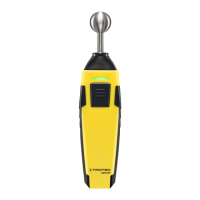EN 17
material moisture measuring device controlled via smartphone BM31WP
• Measuring depth
– Depending on the material's bulk density and degree of
moisture penetration, the device's penetration depth
ranges up to 40 mm. Conclusions regarding zones
located at a lower level cannot be drawn.
• Material characteristics
– Increased occurrences of soluble salts in the measured
material can distort the result of the measurement. The
more salts present, the higher the conductivity of the
material and the higher will be the displayed
measurement value.
– If possible, do not measure wood with a temperature
below -5°C. Too low wood temperatures distort the
result of the measurement.
– The material should be preferably homogenous and not
have any air pockets.
• Electrically conducting materials or electrical fields
– If a construction material contains electrically
conducting substances, the dielectric constant is also
increased, which then simulates high moisture values.
Consequently, a too high measured value will be
displayed.
– From visual inspection it is not always apparent,
whether there are any electrically conducting
substances inside the construction material. Some of
the main error sources here are in particular
reinforcements, metal laminations and conducting
insulation such as slag in timber beam ceiling
constructions. Especially in case of insulation materials
with metal lamination, measured values are often
misinterpreted.
– Avoid static charge of the material to be measured due
to friction. Static charge distorts the measurement
result.
– With a wood moisture of less than 10%RH,
electrostatic forces may occur at the good to be
measured. This can falsify the result of the
measurement. Experience has shown that this occurs at
the outlet of veneer drying plants. Remove the static
charge by use of suitable grounding measures.
– For optimum conditions neither electrical fields nor
conducting materials should be present.
• Surface condition
– Oily and/or aqueous timber preservatives affect the
measurement result.
– The surface of the material to be measured should be
as level as possible to permit thorough contact of the
measuring probe.
• Moisture distribution
– With material thicknesses of less than 2 cm there is a
danger of humidity values from adjacent material layers
affecting the measured value.
– Ideally, the moisture should be evenly distributed within
the material to be measured.
Quantitative conclusions about the moisture content of the
mineral material to be measured can only be drawn by applying
the Darrprocedure or the CMmethod.
Maintenance and repair
Battery change
A battery change is required when the LED at the appSensor
flashes red or the sensor can no longer be switched on. See
chapter Operation.
Cleaning
Clean the device with a soft, damp and lint-free cloth. Make
sure that no moisture enters the housing. Do not use any
sprays, solvents, alcohol-based cleaning agents or abrasive
cleaners, but only clean water to moisten the cloth.
Repair
Do not modify the device or install any spare parts. For repairs
or device testing, contact the manufacturer.

